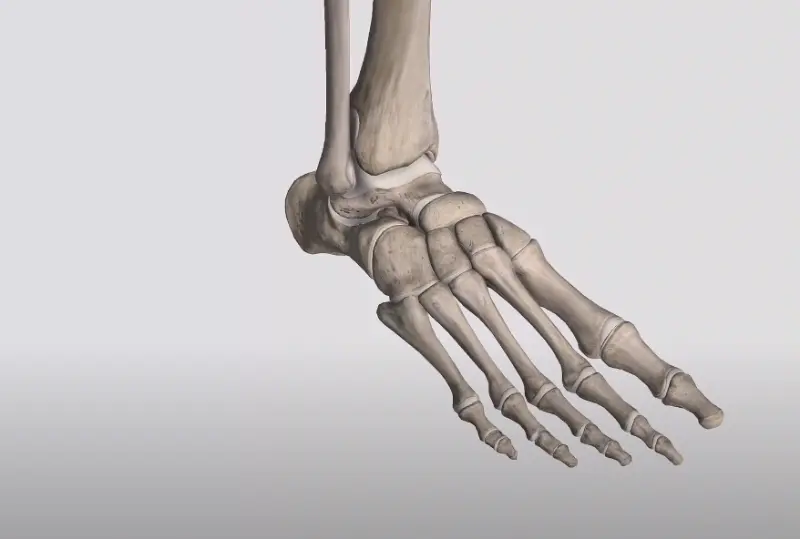Cycling with ankle tendonitis may cause localized pain, swelling, and stiffness. Pain is the initial symptom of foot or ankle tendonitis, which may subside over time but reoccur as you spend more time on your foot or ankle.
It is not recommended to cycle with ankle tendonitis as it puts pressure on the ankle joint and can exacerbate the condition. Cycling requires ankle flexion and extension, which stimulates inflammation and pain.
In this blog post, we’ll explore whether you can cycle with ankle tendonitis, the effects of ankle tendonitis on cycling, precautions, prevention measures, treatment options, and the causes of ankle tendonitis on cycling.
Key Takeaways
- Cycling with ankle peroneal tendonitis requires extra precautions to prevent further damage or pain. It’s important to consult a medical professional before beginning a cycling regimen and to choose the right bike and footwear for your condition. Proper warm-up exercises and avoiding overexertion are essential.
- Risks of cycling with ankle tendonitis include aggravation of the condition, loss of balance, overcompensation, delayed healing, risk of fracture, and inflammation. Prevention measures include proper footwear and equipment, warm-ups, cool-downs, and strengthening exercises and stretching routines. Treatment options for an inflamed tendon in the ankle include rest, ice, compression and elevation (RICE protocol), physical therapy and rehabilitation, anti-inflammatory drugs, and in severe cases, surgery.
- Cycling shoes with stiff soles can provide better support and reduce ankle strain. Wider pedals can also help disperse pressure. Constantly listening to your body signals is crucial. If any pain or discomfort is felt during cycling, it is essential to stop and rest. Long rides should be broken up by regular breaks for stretching and resting the ankles. Footwear should be well-fitted with enough room for toes to move comfortably.
Regular strengthening and stretching exercises can improve joint stability and flexibility, helping to prevent ankle tendonitis.
Can You Cycle With Ankle Tendonitis: 7 Precautions
Cycling can be a great way to stay active and fit, but those with ankle peroneal tendonitis must take extra precautions to avoid further damage or pain. Here are some precautions you can take before cycling with ankle tendonitis:
Consult With Your Doctor or Physical Therapist
Make sure you get medical advice before starting an exercise routine. They can provide valuable, safe exercise guidance and recommend exercises that benefit your condition.
Choose the Right Bike
Different bikes are available in the market, and choosing the one that suits you and your condition is essential. A bike with a more upright posture would be better for ankle tendonitis than a bike with a more aggressive one.
Perform Proper Warm-Up Exercises
Warming up before cycling is essential for preventing further damage or pain. Simple exercises such as ankle rotations and stretching release tight muscles and increase blood flow. Start with a slow-paced ride for the first few minutes to let your body adjust to the motion.
Avoid overexertion
Cycling for extended periods or very high intensity can strain your ankle excessively and lead to ankle pain or discomfort. Always start with low-intensity rides and accumulate the duration and intensity only if your ankles can tolerate it.
Use Proper Cycling Shoes
Having the proper cycling shoes can make a difference in mitigating ankle pain. Cycling shoes with a stiff sole offer better support and can reduce the amount of work your ankle has to do. Using pedals with a broader platform can also help to disperse pressure.
Take Breaks Frequently
Taking breaks frequently is essential to avoid overexertion. During a long ride, take breaks at regular intervals to stretch and rest your ankles. Get off the bike and walk around or do some stretching exercises.
Listen to Your Body
Always pay attention to your body signals. If you feel any pain or discomfort in your ankle while cycling, it is crucial to stop immediately and rest. Do not ignore the pain and never try to push through it, as doing so can cause additional damage or even prolong your recovery time.
6 Effects of Cycling With Ankle Tendonitis
Cycling can be an excellent low-impact exercise option, especially for those with joint or tendon injuries. For those with ankle tendonitis, cycling can be risky. Here are some potential risks to keep in mind:
- Aggravation of the Condition: Cycling can put a significant amount of pressure on the tendons in your ankle. If you have ankle tendonitis, this pressure can cause further inflammation and pain, aggravating your condition.
- Loss of Balance: When cycling, you must maintain balance on the bike, requiring constant ankle movement to maintain proper positioning. Cycling on a sprained ankle can frustrate and increase the risk of falling.
- Overcompensating: When you have ankle peroneal tendonitis, you may subconsciously overcompensate by putting more weight on your uninjured leg. This can lead to further problems, such as hip pain or instability.
- Delayed Healing: To heal correctly, ankle tendonitis requires time to rest and recover. Engaging in cycling too soon can delay the healing process, leading to a prolonged recovery time.
- Risk of Fracture: Cycling can be fun and exhilarating, but it also poses a risk of falls and crashes. If you have ankle tendonitis, your ankle may become unstable, increasing the risk of a fracture in case of an accident.
- Inflammation: Repetitive movements, like cycling, can strain the peroneal tendons, which can lead to inflammation. People with supinated feet, which means having high arches, are more susceptible to stressing the peroneal tendons while cycling because of the thousands of pedal strokes they take.
3 Prevention Tips for Ankle Tendonitis
With proper prevention measures, cyclists can continue to cycle with ankle tendonitis without causing further damage. Effective prevention measures include:
Proper Footwear and Equipment
Wearing adequately fitted cycling shoes will help stabilize your foot and prevent excessive movement that can lead to ankle tendonitis. Ensure your shoes fit well and have enough room for your toes to move comfortably. You may also use orthotics or supportive inserts to provide additional cushioning and support to your feet. You may use pedals with a broader platform or clipless pedals to distribute your weight more evenly and reduce stress on your ankles.
Adequate Warm-up and Cool-down Exercises
You should warm up properly before cycling to prepare your muscles and joints. You may do gentle stretching exercises or ride slowly for a few minutes to increase your heart rate.
Similarly, you should cool down after cycling by reducing your pace and doing some stretching exercises. Taking breaks during your ride and stretching your legs and ankles is also advisable to promote blood flow and reduce pressure on your tendons.
Strengthening Exercises and Stretching Routines
Strengthening your ankles and calf muscles can help prevent ankle tendonitis by improving the stability and flexibility of your joints. Improve ankle strength by doing simple exercises like ankle circles and calf raises.
Stretching exercises can improve your ankle’s range of motion and prevent tightness and stiffness in your tendons. Some recommended stretches for ankle tendonitis are seated calf stretches, wall ankle dorsiflexion, and ankle tendon stretches.
4 Ankle Tendonitis Treatment Options with Cycles
When the tendons in your ankle become inflamed, usually because of overuse or injury, it results in ankle tendonitis. Several treatment options are available to help manage and ease the symptoms, making them manageable.
Rest, Ice, Compress, and Elevate
The Ice protocol is the first line of treatment for ankle tendonitis. It involves:
- Resting the affected ankle to reduce the strain on the tendons.
- The affected area can be treated with ice to ease pain and inflammation.
- Compression is used to reduce swelling and support the ankle.
- Elevating the affected ankle above the level of the heart to reduce swelling.
Physical Therapy and Rehabilitation
Using rehabilitation methods and physical therapy is essential to treating ankle tendonitis. This treatment option helps build strength and increase flexibility, ultimately benefiting the patient and preventing the problem from reoccurring.
You can perform exercises with the help of a physical therapist that can strengthen the muscles, ligaments, and tendons and reduce stress on tendons.
Anti-inflammatory Medications and Pain Relievers
Your doctor may prescribe pain relievers and anti-inflammatory medications to help manage the pain and minimize the inflammation. Nonsteroidal anti-inflammatory drugs (NSAIDs) and ibuprofen can help reduce inflammation and pain. Topical analgesics (pain-relieving creams) can also provide relief and ease pain.
Surgery in Severe Cases
Surgery for ankle tendonitis is rare and only necessary in severe cases that do not respond to other treatments. Surgery involves removing the damaged or inflamed tendon tissue to relieve pain and improve mobility.
Conclusion
Ankle tendonitis can be a painful and debilitating injury derailing your cycling routine. Proper precautions make it possible to resume cycling without worsening the injury. Consulting with a doctor and wearing the footwear can make all the difference in your recovery journey.
Be sure to start slowly and listen to your body to avoid overexertion. Remember that taking care of your injury now will help you return to your favorite bike faster. With patience and determination, you can overcome ankle tendonitis and enjoy the many benefits that cycling offers.
FAQs
Does Ankle Tendonitis Ever Go Away?
Tendonitis typically improves with rest and self-care. If your symptoms persist or worsen after a few days or you experience additional symptoms, it’s advisable to seek medical attention. If the pain is disturbing your sleep or interfering with your daily activities, it’s best to get professional treatment.




